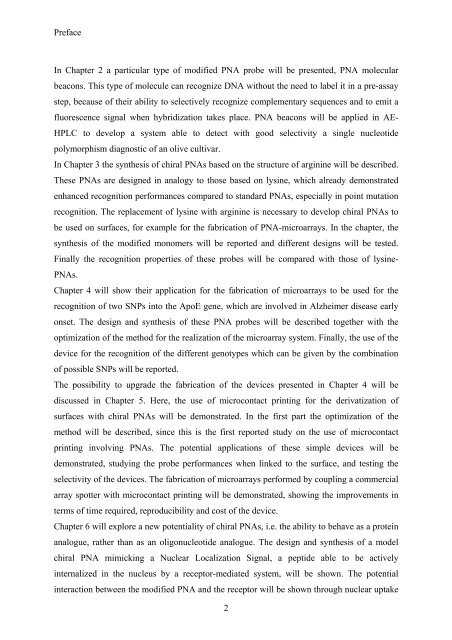View - DSpace UniPR
View - DSpace UniPR
View - DSpace UniPR
Create successful ePaper yourself
Turn your PDF publications into a flip-book with our unique Google optimized e-Paper software.
Preface<br />
In Chapter 2 a particular type of modified PNA probe will be presented, PNA molecular<br />
beacons. This type of molecule can recognize DNA without the need to label it in a pre-assay<br />
step, because of their ability to selectively recognize complementary sequences and to emit a<br />
fluorescence signal when hybridization takes place. PNA beacons will be applied in AE-<br />
HPLC to develop a system able to detect with good selectivity a single nucleotide<br />
polymorphism diagnostic of an olive cultivar.<br />
In Chapter 3 the synthesis of chiral PNAs based on the structure of arginine will be described.<br />
These PNAs are designed in analogy to those based on lysine, which already demonstrated<br />
enhanced recognition performances compared to standard PNAs, especially in point mutation<br />
recognition. The replacement of lysine with arginine is necessary to develop chiral PNAs to<br />
be used on surfaces, for example for the fabrication of PNA-microarrays. In the chapter, the<br />
synthesis of the modified monomers will be reported and different designs will be tested.<br />
Finally the recognition properties of these probes will be compared with those of lysine-<br />
PNAs.<br />
Chapter 4 will show their application for the fabrication of microarrays to be used for the<br />
recognition of two SNPs into the ApoE gene, which are involved in Alzheimer disease early<br />
onset. The design and synthesis of these PNA probes will be described together with the<br />
optimization of the method for the realization of the microarray system. Finally, the use of the<br />
device for the recognition of the different genotypes which can be given by the combination<br />
of possible SNPs will be reported.<br />
The possibility to upgrade the fabrication of the devices presented in Chapter 4 will be<br />
discussed in Chapter 5. Here, the use of microcontact printing for the derivatization of<br />
surfaces with chiral PNAs will be demonstrated. In the first part the optimization of the<br />
method will be described, since this is the first reported study on the use of microcontact<br />
printing involving PNAs. The potential applications of these simple devices will be<br />
demonstrated, studying the probe performances when linked to the surface, and testing the<br />
selectivity of the devices. The fabrication of microarrays performed by coupling a commercial<br />
array spotter with microcontact printing will be demonstrated, showing the improvements in<br />
terms of time required, reproducibility and cost of the device.<br />
Chapter 6 will explore a new potentiality of chiral PNAs, i.e. the ability to behave as a protein<br />
analogue, rather than as an oligonucleotide analogue. The design and synthesis of a model<br />
chiral PNA mimicking a Nuclear Localization Signal, a peptide able to be actively<br />
internalized in the nucleus by a receptor-mediated system, will be shown. The potential<br />
interaction between the modified PNA and the receptor will be shown through nuclear uptake<br />
2
















